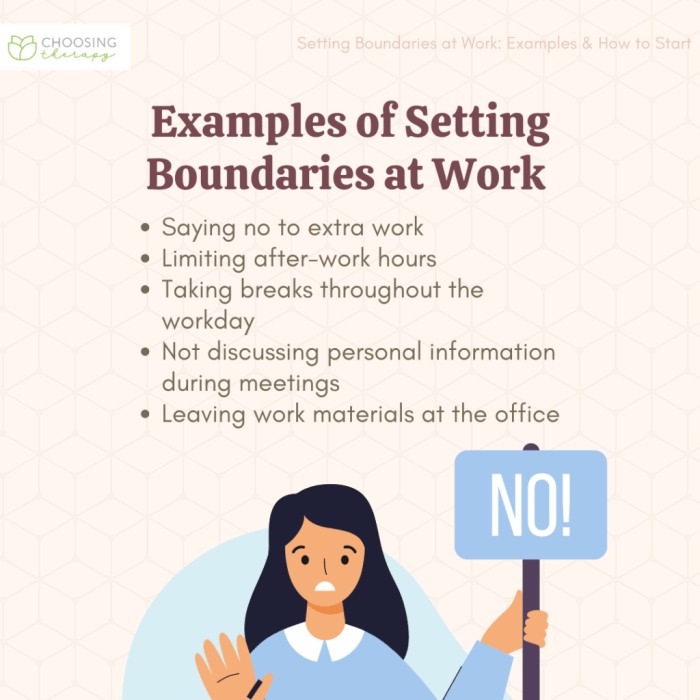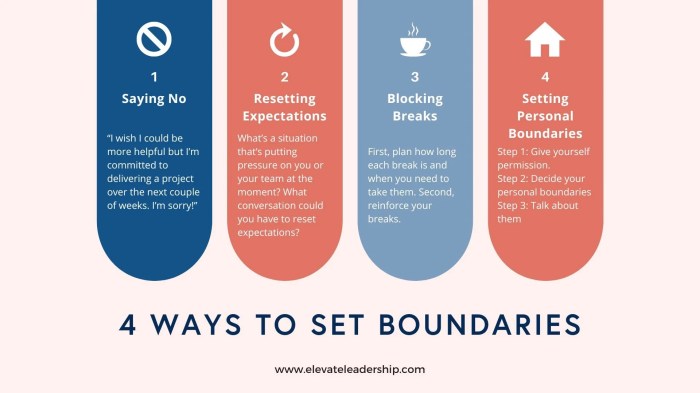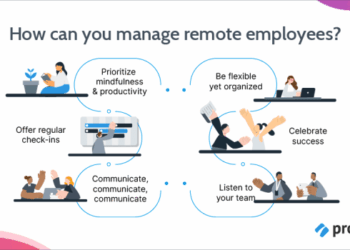As Setting Boundaries: How to Separate Work and Life at Home takes center stage, this opening passage beckons readers into a world crafted with good knowledge, ensuring a reading experience that is both absorbing and distinctly original.
Exploring the nuances of balancing work and personal life within the confines of your home promises to provide valuable insights and practical tips for achieving a harmonious lifestyle.
Importance of Setting Boundaries
Setting boundaries between work and home life is crucial for maintaining a healthy balance and overall well-being. When these boundaries are not clearly defined, it can lead to a range of negative consequences affecting both productivity and personal health.
Impact on Productivity
Blurred lines between work and home life can result in constant distractions and interruptions, making it challenging to focus on tasks effectively. This can lead to decreased productivity as individuals struggle to complete work in a timely manner. Without clear boundaries, the quality of work may also suffer, impacting overall performance and outcomes.
Impact on Well-being
Not having clear boundaries can also take a toll on mental and physical health. Constantly being available for work-related matters, even during personal time, can lead to increased stress, anxiety, and feelings of burnout. The inability to disconnect and recharge can result in fatigue, decreased motivation, and overall dissatisfaction with both work and personal life.
Examples of Blurred Boundaries
- Checking work emails late into the night, affecting sleep quality and relaxation time.
- Taking work calls during family dinners or personal events, causing tension and resentment among loved ones.
- Working on weekends or holidays instead of prioritizing self-care and leisure activities.
Overall, setting boundaries between work and home life is essential for maintaining a healthy balance, improving productivity, and safeguarding personal well-being.
Creating a Dedicated Workspace
Creating a dedicated workspace at home can significantly improve your productivity and mental well-being. Having a separate area for work activities helps establish boundaries between your professional and personal life, allowing you to focus better on tasks at hand.
Benefits of Having a Separate Workspace
- Reduced distractions: A designated work area helps minimize interruptions from family members, pets, or household chores, allowing you to concentrate better.
- Increased productivity: By mentally associating a particular space with work, you can enhance your efficiency and effectiveness in completing tasks.
- Improved work-life balance: Creating a physical separation between work and leisure activities promotes a healthier balance, preventing burnout and exhaustion.
Designing an Ergonomic Home Office
- Choose a quiet area with good lighting: Select a spot in your home that receives natural light and is away from high-traffic areas to create a peaceful work environment.
- Invest in comfortable furniture: Use an ergonomic chair and desk to support proper posture and reduce strain on your body during long work hours.
- Organize your space efficiently: Keep essential items within reach, declutter your workspace, and personalize it with inspiring decor to boost motivation.
Psychological Impact of a Designated Work Area
Having a designated work area can positively impact your mental health and overall well-being. It helps you establish a routine, set boundaries, and create a sense of professionalism even when working from home. By creating a physical separation between work and personal life, you can reduce stress, increase focus, and improve your overall job satisfaction.
Remember, your workspace should be a place where you feel comfortable, inspired, and ready to tackle your tasks efficiently.
Establishing a Routine
Establishing a daily schedule for work and personal time is crucial in maintaining a healthy work-life balance. It helps in setting clear boundaries and ensuring that you have dedicated time for both work and relaxation.
Setting Specific Work Hours
- Define your work hours based on your most productive times of the day.
- Communicate your work hours to your colleagues and family members to avoid interruptions.
- Use tools like time-blocking or scheduling apps to allocate specific tasks to specific hours.
Sticking to the Schedule
- Avoid checking work emails or messages outside of your designated work hours.
- Take regular breaks to avoid burnout and maintain focus during work hours.
- Create a relaxing evening routine to signal the end of the workday and transition into personal time.
Benefits of a Consistent Routine
- Increased productivity and efficiency due to focused work hours.
- Improved work-life balance leading to reduced stress and better overall well-being.
- Enhanced time management skills and better prioritization of tasks.
Communication with Family and Roommates

Effective communication with family or roommates is crucial when setting boundaries between work and personal life at home. It is essential to have open conversations about your work-time and personal-time needs to ensure a supportive environment for maintaining these boundaries.
Tips for Communicating Your Boundaries
- Set aside dedicated time to discuss your work schedule and the importance of uninterrupted work time.
- Clearly communicate your availability for personal activities and family time.
- Use "I" statements to express your needs and boundaries without sounding accusatory.
- Listen actively to the needs and concerns of your family or roommates and find compromises that work for everyone.
Importance of Open Conversations
- Open communication fosters understanding and respect for each other's needs.
- It helps in setting realistic expectations and avoids misunderstandings.
- Having open conversations builds a stronger bond and promotes a supportive environment.
Creating a Supportive Environment
- Encourage a culture of mutual respect and understanding within the household.
- Establish boundaries together as a team to ensure everyone's needs are met.
- Be flexible and willing to adjust boundaries when necessary, considering the needs of all parties involved.
- Regularly check in with each other to ensure that the established boundaries are working effectively.
Closing Notes

In conclusion, mastering the art of setting boundaries between work and home life can lead to enhanced productivity, improved well-being, and a more fulfilling existence. By implementing the strategies discussed, individuals can navigate the challenges of remote work with confidence and success.
Answers to Common Questions
How can I effectively communicate my boundaries with family and roommates?
It's essential to have open conversations, clearly stating your needs and expectations regarding work and personal time. Setting aside dedicated moments to discuss boundaries can prevent misunderstandings and foster a supportive environment.
What are the benefits of maintaining a consistent routine for productivity?
A consistent routine helps in creating a sense of structure and discipline, leading to increased focus and efficiency. By establishing set work hours and sticking to them, individuals can better manage their tasks and achieve a healthy work-life balance.
Why is having a dedicated workspace important for work activities?
A dedicated workspace helps in mentally separating work from personal life, enhancing concentration and minimizing distractions. It also signals a clear boundary between professional duties and leisure time, promoting a healthier work environment.









